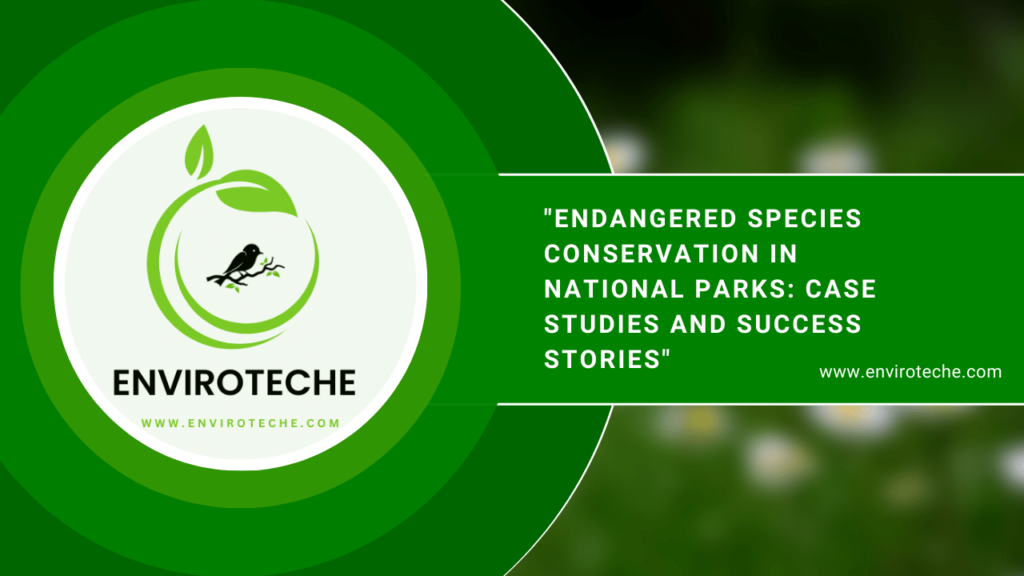
Irfan Haidri1, Qudrat Ullah1
1Department of Environmental Science, Government college university Faisalabad
Introduction:
Due to the protected habitats and resources they offer for these incredibly vulnerable animals and plants, national parks are essential to the conservation of endangered species. These regions serve as refuges for threatened and endangered species, enabling them to rehabilitate and flourish away from anthropogenic activity and development.
Although many species are still in danger as a result of many issues such habitat loss, climate change, poaching, and invasive species, the current state of endangered species in national parks is alarming. The preservation and restoration of endangered species in national parks continues to be a difficult task, despite the efforts of national park administrators, conservation groups, and local people. As a result, ongoing conservation initiatives and partnerships are crucial for guaranteeing both the long-term viability of national parks and the survival of these species.
Case Study 1: Yellowstone National Park
One of the first and most well-known national parks in the country, Yellowstone National Park was created in 1872. Numerous endangered species, like the grey wolf, grizzly bear, and Canada lynx, can be found there. It is also home to a wide variety of flora and fauna. Through a number of initiatives and programmes, the park has achieved tremendous progress in the conservation of these species in recent years.
For instance, thanks to successful reintroduction efforts, the grey wolf population in the park has increased from a small number of animals in the 1990s to over 100 wolves today. Similar to how the grizzly bear population has increased recently, the park is now thought to be home to around 700 bears. These conservation initiatives haven’t been without obstacles, though. The ecosystems of the park have been significantly impacted by human development and activity, including the building of roads and the rise in tourists, endangering the existence of endangered species.
Officials of the park have also faced difficulties as a result of political and legal disputes regarding the management of these species. Despite these difficulties, Yellowstone National Park continues to be an essential fortress for the preservation of threatened and endangered species and stands as an illustration of effective conservation work in national parks (Chitwood, Baruzzi, & Lashley, 2022; Keiter, 2022).
Case Study 2: Everglades National Park
Southern Florida’s Everglades National Park was created in 1947 to preserve the Everglades’ distinctive ecosystem, which consists of swampland, sawgrass prairies, and mangrove forests. Numerous endangered species, such as the Florida panther, West Indian manatee, American crocodile, and wood stork, can be found in the area. The American alligator, which was once in danger of going extinct due to hunting and habitat destruction, is one success story in the park’s effort to save endangered species.
The Cape Sable seashore sparrow and the Miami blue butterfly populations have both been successfully revived thanks to the park’s captive breeding programme. The park must overcome a number of obstacles to preserve endangered species, including invasive species that disturb the natural food chain and environment, including the Australian pine and the Burmese python. Human development and climate change, which may result in habitat loss and altered water levels, are further risks to the park. Despite these obstacles, work is still being done to protect the rare and endangered species found in Everglades National Park (Mullappally, 2022; Rodríguez, 2022; Wilhelm, 2022).
Case Study 3: Gorongosa National Park
Mozambique’s Gorongosa National Park has a long history of conservation efforts as well as hostilities. The park was first constructed in the 1960s, but in the 1980s and 1990s, it was severely affected by the civil war in the nation, which resulted in a sharp fall in wildlife populations. But because to the work of a committed group of conservationists and local communities, the park has seen a remarkable transformation in recent years. African wild canines, lions, and elephants are just a few of the park’s many endangered animals, which have been the subject of significant conservation efforts.
The park has had great success reestablishing these populations through a combination of anti-poaching measures, reintroduction programmes, and community participation efforts. For instance, the number of African wild dogs increased from just six in 2010 to over 200 in 2021. Despite these accomplishments, the park still faces tough obstacles like persistent poaching and the effects of climate change. However, there is still hope for the continuous recovery of Gorongosa’s endangered species thanks to the ongoing dedication of park employees and local residents (Huntley, 2023).
Case Study 4: Serengeti National Park
Tanzania’s Serengeti National Park, which has a surface size of 14,750 square kilometres, was created in 1951. More than 70 different species of large mammals can be found in the park, including numerous endangered ones like the African elephant, black rhinoceros, and cheetah. Through anti-poaching initiatives, habitat restoration projects, and reintroduction programmes, the park has been successful in conserving these threatened species. For instance, the number of black rhinoceroses has increased from just 10 in the 1960s to over 1000 in the present.
Nevertheless, the park still has trouble protecting these species from poaching and habitat loss brought on by human encroachment and climate change. Additionally, the yearly wildebeest migration, which is a significant draw for tourists, might harm the ecosystem of the park if it is not properly managed. Through partnerships with international conservation organisations, community outreach and education initiatives, and other initiatives, the park is attempting to address these issues (Monadjem, 2023; Rugaimukamu, 2022).
Conclusion:
National parks are essential to the preservation of endangered species because they offer places where these creatures can thrive and repopulate after population falls. The conservation efforts in national parks do face difficulties, though, including problems like habitat loss, poaching, and climate change. Despite these difficulties, numerous national parks have had amazing success stories in protecting endangered species.
Examples include the restoration of the California condor population in Zion National Park and the recovery of the grey wolf population in Yellowstone National Park. These triumphs demonstrate how crucial it is to maintain conservation efforts in national parks and how successful conservation can be when given the right tools and backing. The protection of endangered species must remain a top priority for national parks going forward, and government organisations and conservation groups must collaborate to create cutting-edge plans and tactics to address the problems these species confront. By doing this, we can contribute to ensuring the continued existence and prosperity of threatened species for future generations.
References:
Chitwood, M. C., Baruzzi, C., & Lashley, M. A. (2022). “Ecology of fear” in ungulates: Opportunities for improving conservation. Ecology and Evolution, 12(3), e8657.
Huntley, B. J. (2023). Strategic Opportunism: What Works in Africa: Twelve Fundamentals for Conservation Success: Springer Nature.
Keiter, R. B. (2022). Grizzlies, Wolves, and Law in the Greater Yellowstone Ecosystem: Wildlife Management Amidst Jurisdictional Complexity and Tension. Wyo. L. Rev., 22, 303.
Monadjem, A. (2023). AFRICAN ARK: Mammals, Landscape and the Ecology of a Continent: NYU Press.
Mullappally, J. J. (2022). Haptic Memories. University of Cincinnati.
Rodríguez, A. G. (2022). How Immersing Myself in Place Engendered Emergent and Entangled Transformation: Prescott College.
Rugaimukamu, C. (2022). Estimation of foreign tourists’ willingness to pay for conservation of threatened species in Serengeti national park, Tanzania. Sokoine University of Agriculture.
Wilhelm, C. (2022). From Swamp to Wetland: The Creation of Everglades National Park: University of Georgia Press.
Check Other Schlorships:


